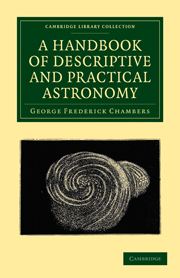Book contents
- Frontmatter
- PREFACE
- SUPPLEMENT
- Contents
- LIST OF ILLUSTRATIONS
- PRINCIPAL AUTHORITIES
- Errata
- A Handbook of Descriptive and Practical Astronomy
- BOOK I A SKETCH OF THE SOLAR SYSTEM
- BOOK II ECLIPSES AND THEIR ASSOCIATED PHENOMENA
- BOOK X METEORIC ASTRONOMY
- CHAPTER I
- CHAPTER II
- CHAPTER III
- APPENDICES
- INDEX TO SUBJECTS
- INDEX TO NAMES
- Plate section
- Frontmatter
- PREFACE
- SUPPLEMENT
- Contents
- LIST OF ILLUSTRATIONS
- PRINCIPAL AUTHORITIES
- Errata
- A Handbook of Descriptive and Practical Astronomy
- BOOK I A SKETCH OF THE SOLAR SYSTEM
- BOOK II ECLIPSES AND THEIR ASSOCIATED PHENOMENA
- BOOK X METEORIC ASTRONOMY
- CHAPTER I
- CHAPTER II
- CHAPTER III
- APPENDICES
- INDEX TO SUBJECTS
- INDEX TO NAMES
- Plate section
Summary
The phenomena, of which we are now about to speak, form a highly interesting and by no means unimportant branch of descriptive astronomy. We shall treat of the subject under three heads: —
Aërolites.
Fireballs.
Shooting Stars.
Of all cosmical meteors, those known as aërolites, meteorlites, or meteoric stones, are the rarest, but nevertheless not so rare as to prevent the most satisfactory evidence being given, that such occurrences have happened from time to time. It is to Chaldni that we owe much of our knowledge on this branch of the subject. Many of these meteoric stones, picked up in different parts of the world, have been subjected to chemical analysis at the hands of Berzelius, Eammelsberg, and others, whose deductions may be thus summed up: —
Meteoric stones are composed of elements all of which occur in terrestrial minerals.
Of the 65 elementary substances known, 19 have been found in meteoric stones.
The produce of a meteoric shower may be divided into meteoric iron and meteoric stone.
Meteoric iron is an alloy that has not been found among terrestrial minerals, and is composed of about 10 per cent, of nickel with small quantities of cobalt, manganese, magnesia, tin, copper, and carbon.
[…]
- Type
- Chapter
- Information
- A Handbook of Descriptive and Practical Astronomy , pp. 392 - 398Publisher: Cambridge University PressPrint publication year: 2010First published in: 1861



